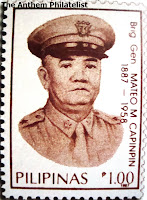Maria Ylagan-Orosa on Stamps

Maria Ylagan-Orosa (29 November 1893 – 13 February 1945) is a Filipino pioneer food technologist, pharmaceutical chemist, humanitarian and war heroine.
Orosa was born on 29 November 1893 in Taal, Batangas to Simplicio Orosa y Agoncillo and Juliana Ylagan. Her brothers and sisters were Simplicio Jr., Vicente, Sixto, Felisa, Jose, Nicolas, and Rafael. She went to elementary and high school in her province. In 1915, she took up a pharmacy course at the University of the Philippines. A year after, she left for the United States as a government scholar.
She enrolled at the University of Seattle as a partial government scholar and earned her degree of Bachelor of Science in Pharmaceutical Chemistry in 1917; a bachelor's degree in Food Chemistry in 1918; a degree in Pharmacy in 1920; and a master's degree in Pharmacy in 1921. Orosa worked as an assistant to Dean Charles Johnson of Washington University in order to support her studies. Upon finishing her studies at the University of Seattle, she was appointed assistant chemist in the State of Washington.
In 1922, Orosa returned to the Philippines and worked as a teacher in Home Economics at the Centro Escolar University. After a year, she transferred to the Bureau of Science as a chemist and traveled throughout the country to promote public and private health through a nutrition program. In 1923, she helped organize the food preservation division under the Bureau of Science. Four years later, she became acting division head. In 1928, the government gave her a scholarship to various countries to specialize in food processing and canning. She returned to the Philippines in 1929 and was appointed head of the home economics division of the Bureau of Science.
On 1 January 1933, she became head of the food preservation division of the bureau. On 1 May 1933, Orosa served as head of the economics division of the Department of Agriculture and Commerce and established the Homemakers Association of the Philippines.
Orosa made many invaluable innovations and experiments in plant utilization, food preservation and canning. She developed the production of vinegar from pineapple. Her best-known invention, however, was the "magic food" Soyalac, a high-protein food derived from soybeans. Orosa is also credited with inventing recipes for banana ketchup, wines from native fruits, banana starch, soyamilk, banana flour, cassava flour, rice cookies from rice bran or darak to prevent beri-beri. Aside from the advances she made in food technology, Orosa also tried to improve household wares by inventing the “Orosa Palayok Oven” for cooking various dishes.
When World War II broke out, Orosa joined the Fil-American Irregular Troops under Brig. Gen. Agustin Marking and was designated captain. She fed and cared for allied prisoners in enemy concentration camps in Tarlac, Pampanga, Laguna, and at the campus of the University of Santo Tomas in Manila.
Her invention, Soyalac, was instrumental in saving thousands of prisoners who would have otherwise died from hunger. While the fight was ongoing between the Japanese and the American forces in Manila, Orosa was hit by shrapnel while at the Bureau of Plant Industry building, located in Malate, Manila and was taken to the Malate Remedios Hospital for treatment. While she was there, however, the hospital was bombed causing her death on 13 February 1945. She was buried in the yard of Malate Catholic School.
The stamp above was issued on June 1, 1993.






